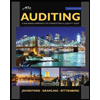
Mylab Accounting With Pearson Etext -- Access Card -- For Auditing And Assurance Services (17th Edition)
17th Edition
ISBN: 9780135176115
Author: Alvin A. Arens, Randal J. Elder, Mark S. Beasley, Chris E. Hogan
Publisher: PEARSON
expand_more
expand_more
format_list_bulleted
Concept explainers
Textbook Question
Chapter 22, Problem 6RQ
Distinguish between (a) tests of controls and substantive tests of transactions and (b) tests of details of balances for liability accounts in the capital acquisition and repayment cycle.
Expert Solution & Answer
Want to see the full answer?
Check out a sample textbook solution
Students have asked these similar questions
General accounting
What were free cash flow and earnings for the period of this financial accounting question?
By how much will the contribution margin increase?
Chapter 22 Solutions
Mylab Accounting With Pearson Etext -- Access Card -- For Auditing And Assurance Services (17th Edition)
Ch. 22 - List four examples of interest-bearing liability...Ch. 22 - Prob. 2RQCh. 22 - Prob. 3RQCh. 22 - Prob. 4RQCh. 22 - Prob. 5RQCh. 22 - Distinguish between (a) tests of controls and...Ch. 22 - Prob. 7RQCh. 22 - Prob. 8RQCh. 22 - Prob. 9RQCh. 22 - Prob. 10RQ
Ch. 22 - Prob. 11RQCh. 22 - Prob. 12RQCh. 22 - Prob. 13RQCh. 22 - Prob. 14RQCh. 22 - Prob. 15RQCh. 22 - Explain the relationship between the audit of...Ch. 22 - Prob. 17.1MCQCh. 22 - Prob. 17.2MCQCh. 22 - Prob. 17.3MCQCh. 22 - Prob. 18.1MCQCh. 22 - Prob. 18.2MCQCh. 22 - Prob. 18.3MCQCh. 22 - Prob. 19.1MCQCh. 22 - Prob. 19.2MCQCh. 22 - Prob. 19.3MCQCh. 22 - Prob. 20DQPCh. 22 - Prob. 21DQPCh. 22 - Prob. 22DQPCh. 22 - Prob. 23DQPCh. 22 - Prob. 24DQPCh. 22 - Prob. 25DQPCh. 22 - Prob. 26DQPCh. 22 - Prob. 27DQPCh. 22 - Prob. 28DQPCh. 22 - Prob. 29DQPCh. 22 - Prob. 30DQP
Knowledge Booster
Learn more about
Need a deep-dive on the concept behind this application? Look no further. Learn more about this topic, accounting and related others by exploring similar questions and additional content below.Similar questions
- Refer to the investment opportunity for 2025 (purchase of new machinery) and calculate the following. Where discount factors are required use only the four decimals present value table (Appendix 1). Ignore taxes. 1. Payback Period (expressed in years, months and days). 2. Accounting rate of return on initial investment (expressed to two decimal places). 3. Net Present Value. Your answer must include the calculation of the present value(s) and NPV. 4. Internal Rate of Return (expressed to two decimal places). Your answer must include two net present value calculations (using consecutive rates/percentages) and interpolation. 5. Internal Rate of Return (expressed to two decimal places) if the machine is expected to have a salvage value of R200 000. Your answer must include two net present value calculations (using consecutive rates/percentages) and interpolation.arrow_forwardWhat is the company's stockholders equity?arrow_forwardPlease provide solution this financial accounting questionarrow_forward
- General accounting questionarrow_forwardGeneral Accountingarrow_forwardA company’s fixed monthly expenses are $35,000, and its contribution margin ratio is 62%. Assuming that the fixed monthly expenses do not change, what is the best estimate of the company's net operating income in a month when sales are $110,000? Helparrow_forward
arrow_back_ios
SEE MORE QUESTIONS
arrow_forward_ios
Recommended textbooks for you
 Auditing: A Risk Based-Approach (MindTap Course L...AccountingISBN:9781337619455Author:Karla M Johnstone, Audrey A. Gramling, Larry E. RittenbergPublisher:Cengage Learning
Auditing: A Risk Based-Approach (MindTap Course L...AccountingISBN:9781337619455Author:Karla M Johnstone, Audrey A. Gramling, Larry E. RittenbergPublisher:Cengage Learning Auditing: A Risk Based-Approach to Conducting a Q...AccountingISBN:9781305080577Author:Karla M Johnstone, Audrey A. Gramling, Larry E. RittenbergPublisher:South-Western College Pub
Auditing: A Risk Based-Approach to Conducting a Q...AccountingISBN:9781305080577Author:Karla M Johnstone, Audrey A. Gramling, Larry E. RittenbergPublisher:South-Western College Pub Accounting Information SystemsAccountingISBN:9781337619202Author:Hall, James A.Publisher:Cengage Learning,Business/Professional Ethics Directors/Executives...AccountingISBN:9781337485913Author:BROOKSPublisher:Cengage
Accounting Information SystemsAccountingISBN:9781337619202Author:Hall, James A.Publisher:Cengage Learning,Business/Professional Ethics Directors/Executives...AccountingISBN:9781337485913Author:BROOKSPublisher:Cengage Intermediate Accounting: Reporting And AnalysisAccountingISBN:9781337788281Author:James M. Wahlen, Jefferson P. Jones, Donald PagachPublisher:Cengage Learning
Intermediate Accounting: Reporting And AnalysisAccountingISBN:9781337788281Author:James M. Wahlen, Jefferson P. Jones, Donald PagachPublisher:Cengage Learning

Auditing: A Risk Based-Approach (MindTap Course L...
Accounting
ISBN:9781337619455
Author:Karla M Johnstone, Audrey A. Gramling, Larry E. Rittenberg
Publisher:Cengage Learning

Auditing: A Risk Based-Approach to Conducting a Q...
Accounting
ISBN:9781305080577
Author:Karla M Johnstone, Audrey A. Gramling, Larry E. Rittenberg
Publisher:South-Western College Pub


Accounting Information Systems
Accounting
ISBN:9781337619202
Author:Hall, James A.
Publisher:Cengage Learning,

Business/Professional Ethics Directors/Executives...
Accounting
ISBN:9781337485913
Author:BROOKS
Publisher:Cengage

Intermediate Accounting: Reporting And Analysis
Accounting
ISBN:9781337788281
Author:James M. Wahlen, Jefferson P. Jones, Donald Pagach
Publisher:Cengage Learning
ACCOUNTING BASICS: Debits and Credits Explained; Author: Accounting Stuff;https://www.youtube.com/watch?v=VhwZ9t2b3Zk;License: Standard Youtube License